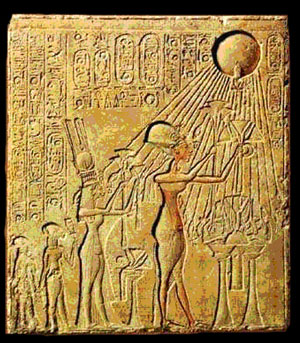The New Kingdom was one of the most prosperous periods of ancient Egyptian history. It begins with the expulsion of the Hyksos at the end of the Second Intermediate Period by Ahmose Nebpehtyre (Ahmose I), and runs until the death of Ramesess XI at the end of the twentieth dynasty and the beginning of the Third Intermediate Period.
The eighteenth dynasty saw a great resurgence in the power and prosperity of Egypt, and included many of its most famous kings and queens. Although Ahmose expelled the Hyksos, it was his son, Amenhotep I, who undertook much of the work to rebuild the country and he was worshiped as a god long after his death.
Tuthmosis I expanded Egyptian control in the Levant and Nubia, and may have been the first pharaoh to build a tomb in the Valley of the Kings. His son, Thuthmosis II undertook some minor military expeditions and building works, but when he died his wife became the famous female pharaoh Hatshepsut. She in turn was succeeded by her step-son, the great general sometimes referred to as the “Napoleon of Egypt”, Thuthmosis III.
Amenhotep II continued his father’s work and was succeeded by his son Thuthmosis IV, the author of the Dream Stele.

Amenhotep III inherited a rich and prosperous nation and enjoyed a very long reign. He is sometimes called the “Sun King” or Amenhotep the Magnificent. His son Amenhotep IV began his reign in the traditional way, but then changed his name to Akhenaten and promoted the Sun disc (the Aten above the other gods. He is considered by some to have been a heretic and megalomaniac, and by others to have been a visionary and the first monotheist. Following his death matters become rather muddy.

It is possible that his wife Nefertiti ruled as Neferneferuaten, or a male relative Smenkhare may have been his successor. The reign of Tutankhamun was short, but made famous by the discovery of his tomb. The old gods were reinstated by Tutankhamun and this was further consolidated by the reign of the general Horemheb, the last pharaoh of the dynasty.
The nineteenth dynasty was inaugurated by Ramesess I, a general of the pharaoh Horemheb, who was succeeded by his son Seti I. Seti was himself an accomplished general who set about reasserting Egypt’s position on the world stage. He was succeeded by his son, Ramesses II.
Also known as Ramesses the Great, he is seen by some as an egotistical propagandist (in part because of his many inscriptions glorifying his “win” at the Battle of Kadesh and the fact that he usurped a great number of statues created by other pharaohs) and by others as an astute and capable ruler. However, his son Merenptah faced increasing problems from external forces collectively known as the “Sea Peoples” and there were successional difficulties created perhaps by the sheer number of Ramesses II progeny. The dynasty ended in the hands of a female pharaoh, Tausret.

Other than the founder Setnakhte, the kings of the twentieth dynasty all took the throne name Ramesses – no doubt in hopes of achieving the success of their illustrious predecessor. However, only Ramesses III came close to living up to the name.
External pressures continued unabated and the increasing power of the priests of Amun added to political strife at home. The dynasty ended with the weak rule of Ramesses XI.
Dynasty Eighteen
(O.C. 1570 – 1293 B.C)
- Ahmose I (Nebpehtyre)
- Amenhotep I (Djeserkare)
- Thuthmosis I ( Akheperkare)
- Thuthmosis II (Akheperenre)
- Hatshepsut (Maatkare)
- Thuthmosis III (Menkheperre)
- Amenhotep II Heqaiunu (Akheperure)
- Thuthmosis IV (Menkheperure)
- Amenhotep III Heqawaset (Nubmaatre)
- Amenhotep IV or Akhenaten (Neferkheperure)
- Smenkhare (Ankhkheperure)
- Tutankhamun or Heqaiunushema (Nebheperure)
- Ay or Itnetjer (Kheperkheperure)
- Horemheb Meryamun (Djeserkheperure Setepenre)
Dynasty Nineteen
(O.C. 1293 – 1185 B.C)
- Ramesses I (Menpehtyre)
- Seti I Merenptah (Menmaatre)
- Ramesses II Meryamun (Usermaatre Setepenre)
- Merenptah Hetephermaat (Baenre-merynetjeru)
- Amenmesses Heqawaset (Menmire-setepenre)
- Seti II Merenptah (Userkheperure-setepenre)
- Siptah Merenptah (Akhenre-setepenre)
- Tausret Setepenmut (Sitremeryamun)
Dynasty Twenty
(O.C.1185-1070 B.C)
- Setnakhte Mereramunre (Userkhaure Setepenre)
- Ramesess III Heqaiunu (Usermaatre Meryamun)
- Ramesses IV (Heqamaatre)
- Ramesses V (Usermaatre)
- Ramesses VI (Nebmaatre Meryamun)
- Ramesses VII (Usermaatre Meryamun Setepenre)
- Ramesses VIII (Usermaatre Akhenamun)
- Ramesses IX (Neferkhare Setepenre)
- Ramesses X (Khepermaatre)
- Ramesses XI (Menmaatre Setepenptah)
Other royalty and officials
Copyright J Hill 2010